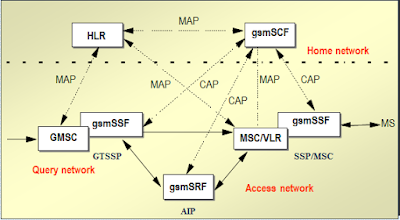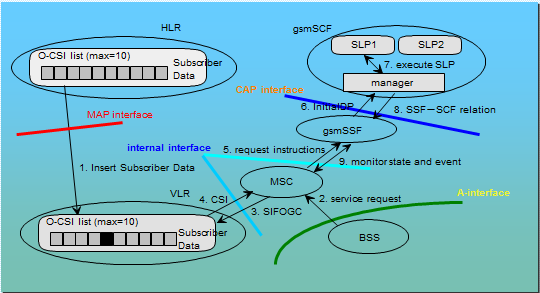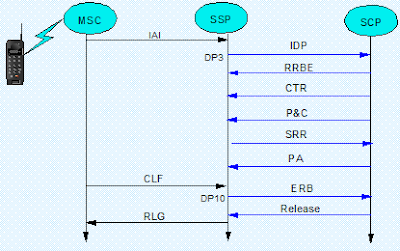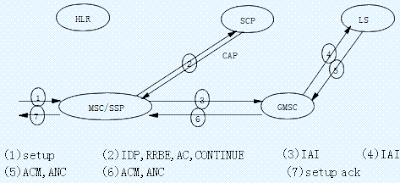What is CAP ?
The abbreviation related to CAP :
CAMEL: Customized
Applications for Mobile Network Enhanced Logic
CAP: CAMEL
Application Part
MAP: Mobile
Application Part
CAMEL standards include Phase 1, Phase 2
and Phase 3. The standardization of Phase 2 was basically completed in March,
1998.
CAMEL adds some FEs to the GSM network: gsmSSF,
gsmSRF and gsmSCF.
1.Network
Structure of CAMEL Phase 1
HLR:
Home Location Register
SSF:
Service Switching Function
MAP:
Mobile Application Part
GMSC:
Gateway MSC
MS:
Mobile Station
VLR:
Visitor Location Register
SCF:
Service Control Function
CAP:
CAMEL Application Part
2.Network
Structure of CAMEL Phase 2
HLR:
Home Location Register
SSF:
Service Switching Function
MAP:
Mobile Application Part
GMSC:
Gateway MSC
MS:
Mobile Station
VLR:
Visitor Location Register
SCF:
Service Control Function
CAP:
CAMEL Application Part
3.Difference between Phase 1 and Phase 2
Compared with CAMEL Phase 1, CAMEL Phase 2 is enhanced in the following aspects:
3.Difference between Phase 1 and Phase 2
Compared with CAMEL Phase 1, CAMEL Phase 2 is enhanced in the following aspects:
- It defined new trigger point;
- It enables the in-band communication with the user, such as tone announcement, etc.;
- USSD coordinates with each other;
- Call process is more controllable;
- GSM supplementary service invoking notifications;
- The charging information can be put in the normal call records.
USSD:
Unstructured Supplement Service Data
4.Entity Description -- HLR
To support the CAMEL services, HLR stores O/T-CSI and SS-CSI.
When the mobile subscribers update the location, or when O-CSI changes, HLR will send O-CSI to VLR.
When HLR responds to a request for route information, HLR will send O/T-CSI back to GMSC.
When the mobile subscribers update the location, or when SS-CSI changes, HLR sends SS-CSI to VLR.
HLR may provide an interface towards gsmSCF to provide information for inquiry. With this function, the gsmSCF can request the HLR for the subscriber status and location, when HLR get the corresponding information from VLR, the information will be sent back to gsmSCF.
O-CSI: Originating_CAMEL Subscriber Information
T-CSI: Terminating_CAMEL Subscriber Information
SS_CSI: Supplement_CAMEL Subscriber Information
In target Mobile GSM network, if normal GSM subscriber wants to use CAMEL services, it must become a subscriber of CAMEL service. So we need to add CAMEL subscriber information (CSI) into the subscriber’s data.
CAMEL includes originating CSI (O-CSI), terminating CSI (T-CSI). The user who subscribes the originating CAMEL services has O-CSI, while the user who subscribes the terminating CAMEL services has T-CSI.
Every subscriber can register 10 O-CSI and 10 T-CSI. O/T-CSI mainly includes:
gsmSCF Address : The gsmSCF address which is visited when the services are triggered.
ServiceKey :The service logic which gsmSCF should executes.
DefaultCallHandling :To continue or release call when the dialogue between gsmSSF and gsmSCF meets error.
TDPList :The TDP list for triggering IN service. O-CSI can only use DP2 and T-CSI can only DP12 at present.
DP Standard :For notifying whether gsmSSF should request instructions form gsmSCF.
CAMEL Capability Handling The CAMEL version which is supported by gsmSCF.
In overlay GSM network, O-CSI and T-CSI are not used. The IN calls are triggered according to the MSISDN segments which are defined on SSP, HLR, MSC/VLR and GMSC.
5.Entity Description -- VLR
When the subscriber roams to the VLR area, VLR stores O-CSI and SS-CSI in the database as part of the subscriber data.
6.Entity Description -- GMSC
When processing the services which need the support of CAMEL, GMSC receives O/T-CSI from HLR and requests instructions from gsmSSF.
GMSC monitors the call states and informs gsmSSF of these states during processing, which makes gsmSSF control the on GMSC.
GMSC/MSC accomplishes CCF function.
7.Entity Description -- MSC
When processing the services which need the support of CAMEL, MSC receives O-CSI from VLR and requests the instruction from gsmSSF.
When processing the services which need the support of CAMEL, MSC receives O-CSI from VLR and requests the instruction from gsmSSF. MSC monitors the requested call status and informs the status to gsmSSF. When processing the invoking of any supplementary services (ECT, CD, MPTY), MSC receives SS-CSI from VLR and notifies MSC that the invoking of the supplementary service shall be sent to gsmSCF.
ECT: Explicit Call Transfer
CD: Call Distribution
MPTY: Multiparty
8.Entity Description -- gsmSSF
The functional entity interface to connect the MSC/GMSC and gsmSCF.
This functional entity contains CAMEL service logic to control the specific services provided by the network operator.
9.Entity Description -- gsmSRF
The functional entity provides various specialized resources, it interfaces with gsmSSF and gsmSCF.
10.HLR -- VLR Interface
This interface is used to send the CAMEL related subscriber data to the visited PLMN and for provision of MSRN.
The interface is also used to retrieve subscriber status and location information of the mobile subscriber or to indicate suppression of announcement for a CAMEL service.
11.HLR -- GMSC Interface
This interface is used for the mobile terminated calls to exchange routing information, subscriber status, location information, subscription information and suppression of announcement.
12.gsmSSF -- GMSC Interface
This is an internal interface.
The interface is described in the specification to make it easier to understand the handling of DPs (arming/disarming of DPs, DP processing etc).
13.gsmSSF -- gsmSCF Interface
This interface is used for gsmSCF to control a specific gsmSSF and request the gsmSSF to establish a connection to gsmSRF.
As an open interface, the gsmSSF-gsmSCF interface is mainly used for gsmSSF to send the gsmSCF a request for instructions.
14.gsmSSF -- MSC Interface
This is an internal interface.
The interface is described in the specification to make it easier to understand the handling of DPs (arming/disarming of DPs, DP processing etc).
15.gsmSCF -- HLR Interface
This interface is used by gsmSCF to request information from HLR.
This interface is also used for USSD operations.
This interface is optional.
16.gsmSCF -- gsmSRF Interface
This interface is used for the gsmSCF to instruct the gsmSRF to play announcements to the subscribers.
17.gsmSCF -- MSC Interface
This interface is used by the MSC to send supplementary service invoking notifications to the gsmSCF
18.CAMEL Subscriber Data
- CAMEL Subscription Information (O/T-CSI), (gsmSCF address, Service Key, Default Call Handling, TDP List, DP criteria, CAMEL Capability Handling)
- USSD CAMEL Subscription Information (U-CSI), Supplementary Service Invoking Notification CAMEL Subscription Information (SS-CSI),
- Location information/Subscriber state Interrogation (Location information and Subscriber State of the Called Party)
- Translation Information Flag (TIF-CSI)
The CAMEL subscriber data is the added data information to the existing data. It includes:
1) CAMEL Subscription Information (O/T-CSI), which includes:
gsmSCF address: The address to be used to access to the gsmSCF for a specific subscriber.
Service Key: Used to identify the gsmSCF of the applied service logic.
Default Call Handling: The Default Call Handling indicates whether the call shall be released or continued in case error occurs in the dialogue between gsmSSF and gsmSCF.
TDP (Trigger Detection Point) List: The TDP List indicates which detection point is triggered. For the call initiated by mobile subscriber DP2 is triggered, for the call to a mobile subscriber DP12 is triggered.
DP (Detection Point) criteria: The DP criteria indicates whether the gsmSSF shall request the gsmSCF for instructions.
CAMEL Capability Handling: CAMEL Capability Handling indicates the phase of CAMEL which is asked by the gsmSCF for the service.
2) USSD CAMEL Subscription Information (U-CSI), which includes:
Service Code: Service code is for a specific application in a gsmSCF which interacts with the user by USSD.
gsmSCF address: Address to be used to access the gsmSCF for a specific subscriber and a specific service code.
3) Supplementary Service Invoking Notification CAMEL Subscription Information (SS-CSI), which includes:
Notification criteria: This data indicates for which supplementary services notifications shall be sent. The supplementary services which may be indicated are ECT, CD and MPTY.
gsmSCF address: Address to be used to access the gsmSCF for a particular subscriber.
4) Location information/Subscriber state Interrogation
This data indicates whether additional subscriber information shall be sent to the GMSC as part of the terminating call handling.
an indication that the HLR shall send the location information of the called subscriber.
an indication that the HLR shall send the subscriber state of the called subscriber.
5) Translation Information Flag (TIF-CSI)
A flag (TIF-CSI) in the CAMEL Subscriber data in the HLR indicates, when the subscriber registers a forwarded-to number, that the HLR shall not attempt to perform any translation, number format checks, prohibited FTN checks, call barring checks (cf. 0).
If the flag is absent, this indicates that a translation is needed in the HLR and the usual procedure applies as defined in the current version of TS GSM 03.82. In particular, the interaction with barring services shall be performed by the HLR at the registration of the FTN.
19.The Position of CAP and MAP in CCS7
INAP: IN Application Protocol
MAP: Mobile Application Part
MAP: Mobile Application Part
CAP: CAMEL Application Part
TCAP: Transaction Capability Application Part
TCAP: Transaction Capability Application Part
TUP: Telephone User Part
ISUP: ISDN User Part
ISUP: ISDN User Part
MTP: Message Transfer Part
SCCP: Signaling Connection Control
SCCP: Signaling Connection Control
CAP (CAMEL Application Part) is the application part of CAMEL. It is based on the INAP protocol of IN. In Phase 1, CAP defines the information flow between gsmSSF and gsmSCF. In Phase 2, it defines not only the interface between gsmSSF and gsmSCF, but also the interface between gsmSRF and gsmSCF.
MAP (Mobile Application Part) is the mobile application part in the GSM system. It provides GSM system with necessary signaling functions. These functions are required when SS7 provides necessary services (like the voice and non-voice application in PLMN). In GSM Phase 2+, in order to meet the CAMEL network requirement, a group of MAP operations are added, and a number of MAP operations are modified.
CAP and MAP are both protocols in the application layer and belong to the TCAP.
II.CAP Operations
CAP operations are classified into 4 class;
class 1 both result and error are reported
class 2 only error is reported
class 3 only result is reported
1.CAP
Operations –
Initial DP (IDP)
This operation is sent by the gsmSSF after a TDP is detected in the BCSM, to request the gsmSCF for instructions to complete the call.
An
example of Initial DP message:
CAPInitialDP:
serviceKey=1
calledPartyNumber=NOT
PRESENT
callingPartyNumber="8619770001"
callingPartysCategory="0x0a"
locationNumber="86755"
originalCalledPartyID=NOT
PRESENT
highLayerCompatibility=NOT
PRESENT
bearerCapability=NOT
PRESENT
eventTypeBCSM=2
extensions=NOT
PRESENT
additionalCallingPartyNumber=NOT
PRESENT
redirectingPartyID=NOT
PRESENT
redirectionInformation=NOT
PRESENT
imsi=NOT
PRESENT
subscriberState=NOT
PRESENT
locationInformation=NOT
PRESENT
ext_BasicServiceCode=NOT
PRESENT
callReferenceNumber=02
0b 00 00 01 06 01 fd
mscAddress="8613900282"
calledPartyBCDNumber="867556660003"
iPSSPCapabilities
= 01 00 00 00
2.Request Report BCSM Event (RRBE)
Event Report BCSM (ERB)
1.Request Report BCSM Event (RRBE)
This operation is used to request the gsmSSF to monitor a call-related event.
2. Event Report BCSM (ERB)
This operation is used to notify the gsmSCF of a call related event previously requested by the gsmSCF in an RequestReportBCSMEvent operation.
An
example of RRBE message:
CAP
RequestReportBCSMEvent:
bcsmEvents=
[0]=
eventTypeBCSM=4 ;Route Selection Error
monitorMode=0
legID=NOT
PRESENT
dpSpecificCriteria=NOT
PRESENT
[1]=
eventTypeBCSM=5 ;Called Party Busy
monitorMode=0
legID=NOT
PRESENT
dpSpecificCriteria=NOT
PRESENT
[2]=
eventTypeBCSM=6 ;No Answer
monitorMode=0
legID=NOT
PRESENT
dpSpecificCriteria=
applicationTimer=65
[3]=
eventTypeBCSM=10 ;Caller Release
monitorMode=1
legID=NOT
PRESENT
dpSpecificCriteria=NOT
PRESENT
[4]=
eventTypeBCSM=9 ;Call is cut off from caller party.
monitorMode=0
legID=
sendingSideID
= Calling
dpSpecificCriteria=NOT
PRESENT
[5]=
eventTypeBCSM=9 ;Call is cut off from called party.
monitorMode=0
legID=
sendingSideID
= Called
dpSpecificCriteria=NOT
PRESENT
An
example of ERB:
CAP
EventReportBCSM:
eventTypeBCSM=9 ;DP9
eventSpecificInformationBCSM=
oDisconnectSpecificInfo=
releaseCause="0x10
fb
ff
ff“
legID=
receivingSideID=Called ;Call is cut off from called party
miscCallInfo.messageType=0TCInvoke:
dialogueID=507
operationType=0
invokeID=3
linkedID=-1
operationID=24
lastComponent=1
timeout=0
3.Apply Charging (AC)
Apply Charging Report (ACR)
- Apply Charging (AC)
This operation is used for interaction between the charging mechanisms of gsmSCF and gsmSSF.
2. Apply Charging Report (ACR)
This operation is used by the gsmSSF to report charging related information to the gsmSCF as requested by the gsmSCF using the "ApplyCharging" operation.
An example of AC:
CAP ApplyCharging
AChBillingChargingCharacteristics
TimeDurationCharging
maxCallPeriodDuration : 3000
sendCalculationToSCPIndication is :False
sendingSideID = CallingManage
An example of ACR:
CAP ApplyChargingReport
CallResult
timeDurationChargingResult
receivingSideID=Calling
timeInformation
timeIfNoTariffSwitch : 80
callActive : False
Charge by pulse
First call period
Cost in TA is 570.000000
TA >= Tcp
Last call period is : 8 seconds , 23:26:19 to 23:26:27
Normal charge rate is : 500.000000 fen
Last period normal cost is : 500.00 fen
Time to fill charge pulse is: 52 seconds
Mobile charge rate is : 50.000000 fen every minute
Last period mobile cost is : 50.00 fen
Roam charge rate is : 20.000000 fen every minute
Last period mobile cost is : 20.00 fen
Total call duration is : 8 seconds
Total call cost is : 570.00 fen
This operation is used to request the gsmSSF to proceed with call processing at the DP at which it previously suspended call processing to await gsmSCF instructions
This operation is used to request the gsmSSF to proceed with call processing at the DP at which it previously suspended call processing to await gsmSCF instructions
4.Connect to Resource (CTR)
Disconnect Forward Connection (DFC)
- Connect to Resource (CTR)
This operation is used to connect a call from the gsmSSF to a specialized resource.
- Disconnect Forward Connection (DFC)
This operation is used to discnnect a forward connection to an gsmSRF or an assist SSF.
An example of P&C
========== msgID=48 ==============CAP PromptAndCollectUserInformation:
collectedInfo=
collectedDigits=
minimumNbOfDigits=1
maximumNbOfDigits=1
endOfReplyDigit="N"
cancelDigit="*"
startDigit="N"
firstDigitTimeOut=5
interDigitTimeOut=5
errorTreatment=0
interruptableAnnInd=TRUE
voiceInformation=FALSE
voiceBack=FALSE
disconnectFromIPForbidden=TRUE
informationToSend=
inbandInfo=
messageID=
elementaryMessageID=0x1000008(16777224)
numberOfRepetitions=1
duration=0
interval=0ManageArgument to active Dialogue Tracing
5.Play Announcement (PA)
Prompt and Collect Subscriber Information (P&C)
Specialized Resource Report (SRR)
- Play Announcement (PA)
This operation is used for playing announcement to user.
- Prompt and Collect Subscriber Information (P&C)
This operation is used to interact with the calling party in order to collect information.
- Specialized Resource Report (SRR)
This operation is used as the response to a "Play Announcement" operation when the announcement completed indication is set.
An example of P&C:
CAP
PromptAndCollectUserInformation:
collectedInfo=
collectedDigits=
minimumNbOfDigits=1
maximumNbOfDigits=1
endOfReplyDigit="N"
cancelDigit="*"
startDigit="N"
firstDigitTimeOut=5
interDigitTimeOut=5
errorTreatment=0
interruptableAnnInd=TRUE
voiceInformation=FALSE
voiceBack=FALSE
disconnectFromIPForbidden=TRUE
informationToSend=
inbandInfo=
messageID=
elementaryMessageID=0x1000008(16777224)
numberOfRepetitions=1
duration=0
interval=0ManageArgument to active
Dialogue Tracing
What is Connect, Release Call, Cancel?
- Connect
This operation is used to request the gsmSSF to perform the call processing actions, i.e., routing a call to a specific destination or to influence other call set-up information.
- Release Call
This operation is used to clear all the call parties at any stage of the current call.
- Cancel
This gsmSCF uses this class 2 operation to request the gsmSRF to cancel a correlated previous operations, it can be either a "PlayAnnouncement" or a "PromptAndCollectUserInformation".
Three Detection Points
-- DP2: O_Collected_Info
-- DP3: O_Analyze_Info
-- DP12: Terminal Attempt Authorized
An important difference between CAMEL services and IN services of PSTN is in that the IN services of PSTN are triggered by DP3, and IN services can be set in the called analyzer, while CAMEL services are usually triggered by DP2 . Once a mobile subscriber subscribes for a certain CAMEL service, the collective information will be sent directly to gsmSCF, performing called analysis for it.
When the MS originates a call, the service is triggered by DP2. Based on the subscriber's O-CSI information, MSC/SSP can determine whether the subscriber has subscribed for the CAMEL service, addresses according to the SCF address and determines the type of a particular service of the SCF by means of the service key.
When the mobile station terminates the call, GMSC/MSC sends the "Send Routing Information" message to HLR, whose response includes the MS's O/T-CSI information. GMSC/SSP adopts DP12 trigger, analyzes T-CSI information and defines the service type according to the service key.
III.CAP Operation Flow Examples
1.O-CSI Trigger Flow
2.T-CSI Trigger Flow
3.A call from PPS to PSTN
4.A call from PPS to GSM
5.A call from PPS to PPS
6.A call from PSTN or GSM to PPS
7.PPS Balance Query
8.PPS as a Caller in Target Network
9.PPS as a Called in Target Network

















0 comments:
Post a Comment
If there is any comments,Please leave a comment at here.